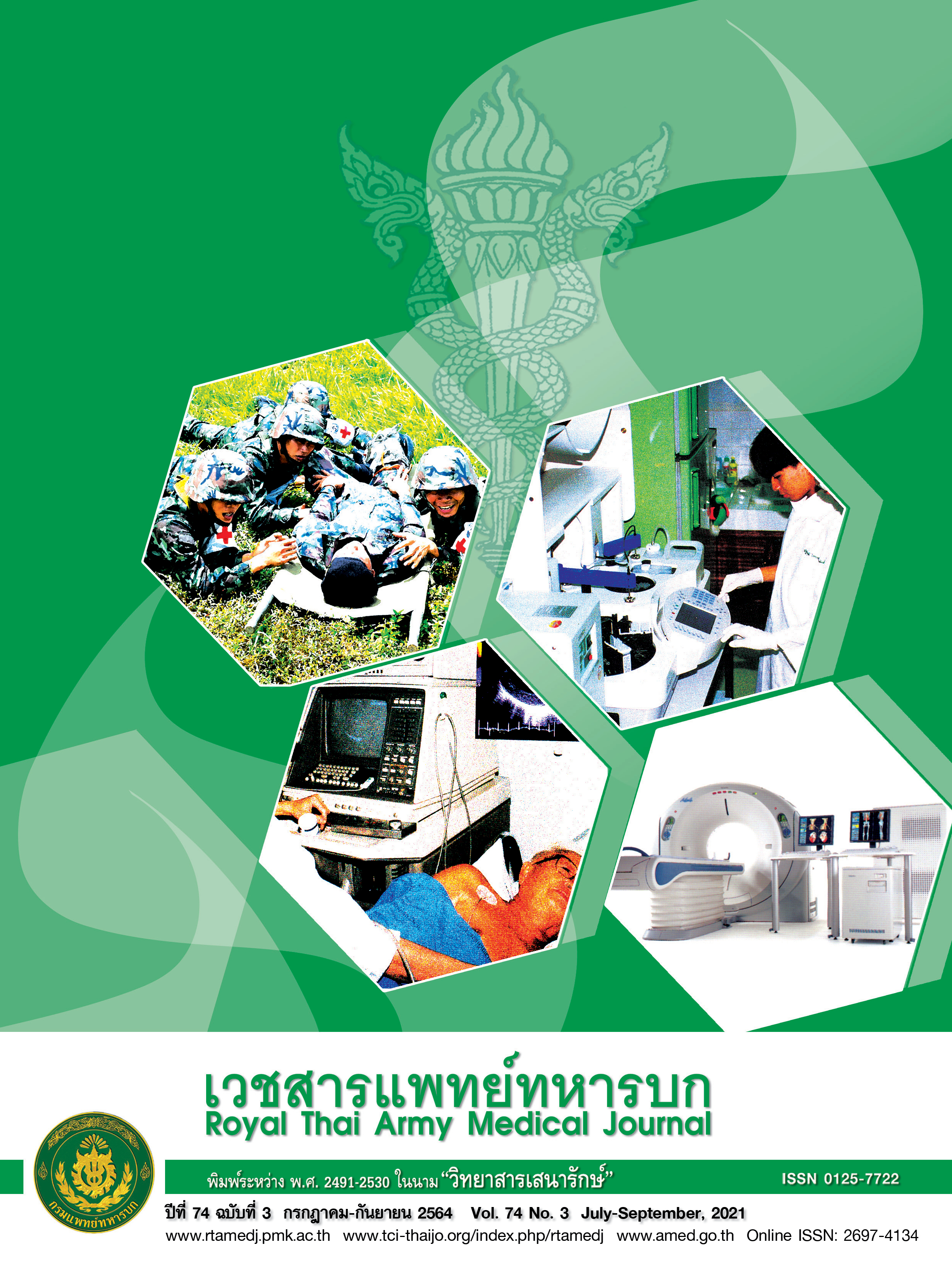Comparison of Planning Quality between Intensity Modulated Radiation Therapy, Volumetric Modulated Arc Therapy and Hybrid technique for Left-sided Breast Cancer Irradiation
Main Article Content
Abstract
This research compares the quality of the radiotherapy plan between the IMRT plan, the VMAT plan, and the hybrid plan for postmastectomy left-side breast cancer irradiation. This is a retrospective study of 15 patients. All three technique of radiotherapy plans were using the Monaco treatment planning system. The IMRT plan uses 7 fix beams and the VMAT plan uses the 2 arcs. The Hybrid plan was combined the IMRT of 3 beams with a weight of 75% and the VMAT of 2 arcs with the weight of 25%. The dosimetric parameters used for evaluating the quality of the three types of treatment plans were including the mean target volume dose(D50), the conformity index (CI), the uniformity index (HI) and the comparison of the radiation dose to organ at risks. The result, when considering PTV_CW, the D50 of the VMAT plan is statistically significant closer to the prescription dose than the IMRT plan and Hybrid plan. The Dmax value of the Hybrid plan is statistically significant lower than the other two plans. VMAT plans and Hybrid plans had the same CI values and are statistically significant better than the IMRT plan. Considering the organ at risks dose, the hybrid plan gave the minimum V5Gy dose to the contralateral breast and the contralateral lung with statistically significant compared to the other two plans. The VMAT plan provided the minimum V30Gy to the ipsilateral lung and the minimum V20Gy to the heart with both statistically significant.
Downloads
Article Details
Articles in this journal are copyrighted by the Royal Thai Army Medical Department and published under the Creative Commons Attribution-NonCommercial-NoDerivatives 4.0 International (CC BY-NC-ND 4.0) license.
may be read and used for academic purposes, such as teaching, research, or citation, with proper credit given to the author and the journal.
Use or modification of the articles is prohibited without permission.
Statements expressed in the articles are solely the opinions of the authors.
Authors are fully responsible for the content and accuracy of their articles.
Any other republication of the articles requires permission from the journal.
References
2. Overgaard, M. Overview of randomized trials in high risk breast cancer patients treated with adjuvant systemic therapy with or without postmastectomy irradiation. Semin Radiat Oncol. 1999; 9: 292-299.
3. Darby, S.C.; McGale, P.; Taylor, C.W.; et al. Long-term mortality from heart disease and lung cancer after radiotherapy for early breast cancer: Prospective cohort study of about 300,000 women in US SEER cancer registries. Lancet. Oncol. 2005;6:557–65.
4. Lingos, T.I.; Recht, A.; Vicini, F.; et al. Radiation pneumonitis in breast cancer patients treated with conservative surgery and radiation therapy. Int. J. Radiat. Oncol. Biol. Phys. 1991;21:355–60.
5. Loic F, Geogges N, Jean-Jacques M, Pierre B. Conformity index: a review. Int J Radiat Oncol Biol Phys 2006; 64:333-42.
6. Yoon M, Park SY, Shin D, Lee SB, Hong RP, Kim DY, et al. A new homogeneity index based on statistical analysis of the dose-volume histograms. Am Coll Med Phys 2007; 8:9-17.
7. Karen Lang, Brianne Loritz and Adam Schwartz et al. Dosimetric comparison between volumetric-modulated arc therapy and a hybrid volumetric-modulated arc therapy and segmented field-in-field technique for postmastectomy chest wall and regional lymph node irradiation. Medical Dosimetry. 2019; 9:43.
8. Jia-Fu Lin, Dah-Cherng Yeh, Hui-Ling Yeh, Chen-Fa Chang, Jin-Ching Lin. Dosimetric comparison of hybrid volumetric-modulated arc therapy, volumetric-modulated arc therapy, and intensity-modulated radiation therapy for left-sided early breast cancer. Medical Dosimetry. 2015; 40: 262-267.
9. Yingjie Xu et al. Locoregional irradiation including internal mammary nodal region for left-sided breast cancer after breast conserving surgery: Dosimetric evaluation of 4 techniques. Medical Dosimetry. 2019; e13–e18.


